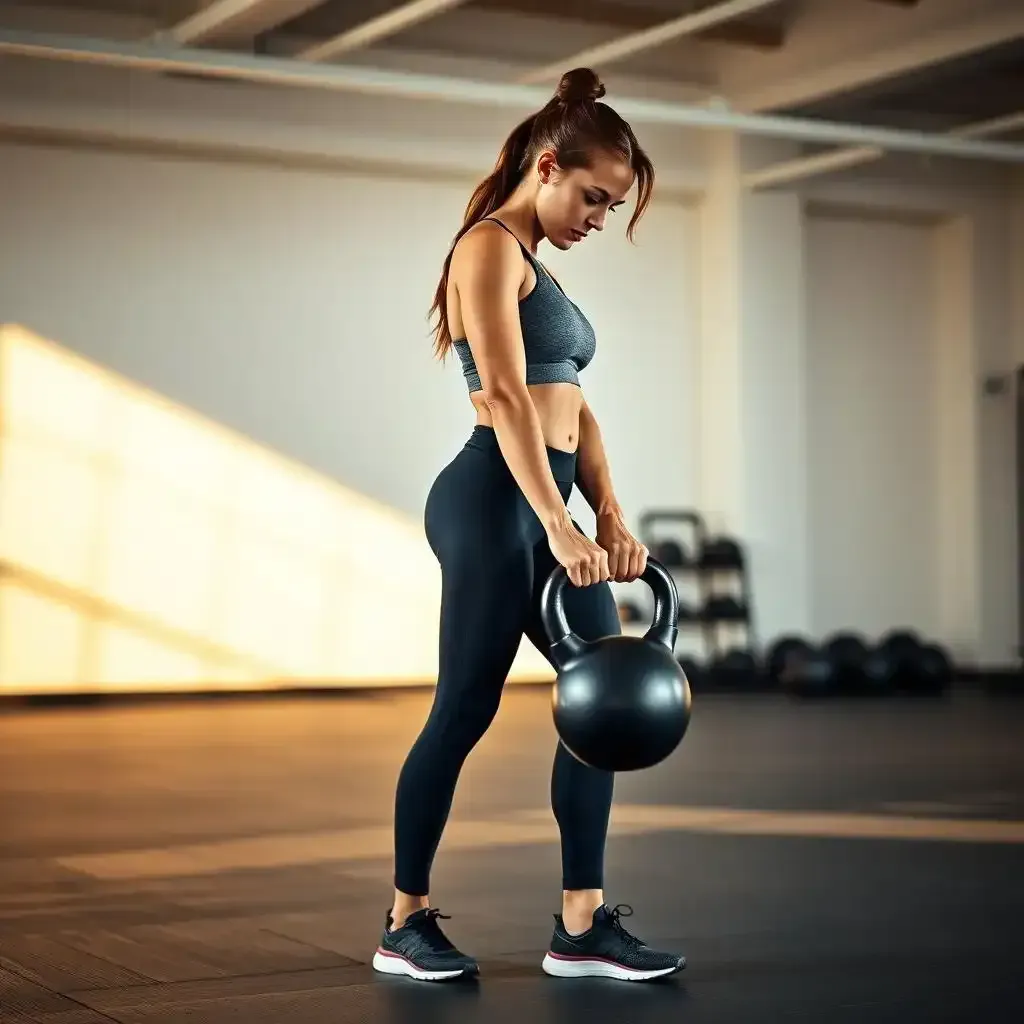Table of Contents
Kettlebell exercises have become increasingly popular due to their versatility and effectiveness in improving overall strength and endurance. However, one of the lesser-known benefits of kettlebell exercises is their ability to improve posture. At kettlebellworkout.homes, we want to help you understand how kettlebell for posture improvement can benefit your overall health and provide you with the knowledge you need to start your kettlebell process. In this article, we will discuss the benefits of kettlebell exercises for posture improvement, effective kettlebell exercises for strengthening your posterior chain, and provide tips for proper kettlebell form and technique to enhance posture. By the end of this article, you will have a clear understanding of how to incorporate kettlebell exercises into your workout routine to improve your posture and strengthen your posterior chain.
The Benefits of Kettlebell for Posture Improvement

The Benefits Of Kettlebell For Posture Improvement
Strengthening Your Core and Back
Hey there, fellow fitness enthusiast! Let's talk about kettlebells and posture. I’ve been using kettlebells for years, and I've seen firsthand how they've completely transformed my posture. It used to be terrible – slumped shoulders, rounded back – the works! Now? I stand taller, feel stronger, and even my clothes fit better. That's the ability of kettlebells, my friend.
Think of your core as the foundation of a house. If the foundation is weak, the whole house wobbles. Kettlebell exercises, like swings and Turkish get-ups, are amazing for building a super-strong core. A strong core helps stabilize your spine, keeping you upright and preventing that slouch. It's like building a solid foundation for your posture. And guess what? A strong core isn't just about six-pack abs; it's about overall stability and balance, which are key for good posture. Want to learn more about building a strong core? Check out our guide on kettlebell core exercises!
- Improved core strength
- Better spinal stability
- Reduced back pain
Improved Muscle Balance
We often spend hours hunched over computers or staring at our phones. This creates muscle imbalances – tight chest muscles pulling your shoulders forward, weak back muscles letting your posture sag. Kettlebells help fix this. Exercises like rows and deadlifts target those often-neglected back muscles, creating better balance. It's like giving your back the attention it deserves, counteracting the effects of all that screen time.
Think of it like a seesaw. If one side (your chest) is heavier, you'll be all out of whack. Kettlebells help even things out, strengthening your back muscles to counter the pull of your chest muscles. This balanced approach is crucial for maintaining a healthy posture and preventing pain. I know, I know, it sounds simple, but it's the small things that make a big difference! For more tips on kettlebell exercises, visit our kettlebell workout tips page.
Muscle Group | Kettlebell Exercise |
|---|---|
Back | Rows, Deadlifts |
Chest | Presses (carefully!) |
Shoulders | Overhead Press, Clean & Jerk |
Effective Kettlebell Exercises for Strengthening Your Posterior Chain

Effective Kettlebell Exercises For Strengthening Your Posterior Chain
Kettlebell Swings: The Foundation of Posterior Chain Strength
Okay, so you wanna know about kettlebells and posture? Let me tell you, kettlebell swings are where it's at! They're like the ultimate back-strengthening exercise. Seriously, I used to have a posture that could rival a question mark, but now? I'm practically a human exclamation point! The swing works your entire posterior chain – that's your glutes, hamstrings, lower back, and even your shoulders. It's all about that hinge movement, like you're trying to touch your toes while keeping your back straight. It's not just about lifting the weight; it's about controlling it, engaging those muscles, and feeling the burn. For beginners, check out our guide on kettlebell exercises for starters.
Think of it like this: your posterior chain is the engine of your body. A strong engine means better posture, more strength, and less chance of injury. I've seen people with terrible posture completely change their form in a few short weeks using kettlebell swings. And don't worry, it's not some complicated dance move. With practice, you'll nail it. Need a visual? Hop over to our kettlebell form guide for some video demonstrations.
- Builds explosive ability
- Improves hip mobility
- Strengthens core muscles
Beyond the Swing: More Posterior Chain Powerhouses
But hey, don't think kettlebell swings are the *only* game in town. There are tons of other amazing exercises that work your posterior chain. Deadlifts, for instance, are a classic for a reason. They're fantastic for building strength in your hamstrings and glutes, which are super important for maintaining good posture. Think of them as the anchor for your body, keeping you grounded and upright. And then there are Romanian deadlifts (RDLs) – these are great for targeting the hamstrings specifically, which often get neglected. Don't worry if you're not familiar with all these terms. We've got a great guide to back exercises on our site.
I remember when I first started, I was so focused on the "big" exercises that I completely ignored smaller, crucial ones like good mornings and glute bridges. These might seem simple, but they're essential for building up the smaller muscles that support your spine. It's all about building a solid foundation for your posture – and these exercises are the perfect building blocks. Remember, consistency is key! Start slow, master the technique, and gradually increase the weight. For more tips and tricks, check out our page.
Exercise | Primary Muscles Worked | Posture Benefit |
|---|---|---|
Kettlebell Swings | Glutes, Hamstrings, Lower Back | Improved spinal stability |
Kettlebell Deadlifts | Hamstrings, Glutes, Lower Back | Stronger back muscles |
Good Mornings | Lower Back, Hamstrings | Increased lumbar spine strength |
Tips for Proper Kettlebell Form and Technique to Enhance Posture

Tips For Proper Kettlebell Form And Technique To Enhance Posture
Alright, let's talk kettlebell form. It's not just about swinging that weight around; it's about doing it *right*. Think of your body as a finely tuned machine – if you use it wrong, it'll break down. And trust me, bad form leads to injuries, which nobody wants! So, let's get you moving safely and effectively. First, find a comfortable, stable stance. Feet shoulder-width apart is usually a good starting point. You want to feel grounded and balanced. Don't be afraid to adjust your feet until you find what works best for you. For more tips on good posture, check out our kettlebell posture tips page.
Next up: your core. Engage it! This isn't some abstract concept; it's about bracing your abdominal muscles, like you're preparing for a punch. This is your body's natural support system. A strong core keeps your spine stable, preventing that dreaded slouch. And it helps you control the weight, preventing those awkward wobbles that can lead to injury. If you're struggling to find your core, don't panic! Many find it easier to find their core muscles when they have a good kettlebell grip. We've got a whole guide on kettlebell grip strength that might help.
- Find a stable stance.
- Engage your core muscles.
- Maintain a straight back.
Now, let's talk about your back. Keep it straight, but not stiff. Think of it like a tall, proud tree, not a wilting flower! This is super important for preventing injury and maximizing the effectiveness of your workout. A rounded back puts unnecessary stress on your spine, and that's a recipe for disaster. So, stand tall, shoulders back, and chest open. If you need more help with your back, we have a whole guide dedicated to .
Finally, breathe! It sounds silly, but it's crucial. Controlled breathing helps you maintain control and capability throughout the exercise. Inhale before you start the movement, exhale during the exertion, and then breathe normally between reps. It might seem minor, but trust me, it makes a world of difference. For more breathing tips, check out our page on kettlebell breathing techniques.
Body Part | Tip |
|---|---|
Feet | Shoulder-width apart |
Core | Engaged and braced |
Back | Straight, but not stiff |
Breathing | Controlled and consistent |
Creating a Kettlebell Workout Routine for Better Posture
Crafting a well-rounded kettlebell workout routine is key to improving your posture and overall fitness. When creating your routine, focus on exercises that target your core, back, and glutes. A strong posterior chain is essential for maintaining upright posture, so don't neglect these areas! For inspiration, check out my beginner's guide to kettlebell workout routines for beginners.
When designing your routine, consider starting with kettlebell swings, deadlifts, and rows. These exercises will help you build a strong foundation for your posterior chain. Don't forget to incorporate exercises that target your core, such as planks and Russian twists. A strong core will help stabilize your spine and improve your overall posture. For more advanced kettlebell exercises, check out my kettlebell exercises for experts guide.
Day | Exercise | Reps | Sets |
|---|---|---|---|
Monday | Kettlebell Swings | 12-15 | 3-4 |
Tuesday | Kettlebell Deadlifts | 8-12 | 3-4 |
Wednesday | Rest Day | - | - |
Thursday | Kettlebell Rows | 12-15 | 3-4 |
Friday | Kettlebell Plank | 30-60 seconds | 3-4 |
- Warm up with 5-10 minutes of light cardio and dynamic stretching
- Start with lighter weights and progress to heavier ones as you become more comfortable with the exercises
- Focus on proper form and technique throughout each exercise
- Rest for 60-90 seconds between sets, and 120-180 seconds between exercises
Remember, consistency is key when it comes to improving your posture. Aim to work out with kettlebells at least 2-3 times per week, and incorporate exercises that target your posterior chain and core. With time and practice, you'll start to notice improvements in your posture and overall fitness. Happy training!
Final Thought
In conclusion, kettlebell exercises can be a valuable addition to your workout routine, especially when it comes to improving your posture. By incorporating exercises that target your posterior chain, you can strengthen your muscles and improve your overall posture. Remember to always start with proper form and technique, and gradually increase the intensity and difficulty of your workouts as you become more comfortable. With consistent practice and patience, you can achieve improved posture and enjoy the many benefits that come with it.